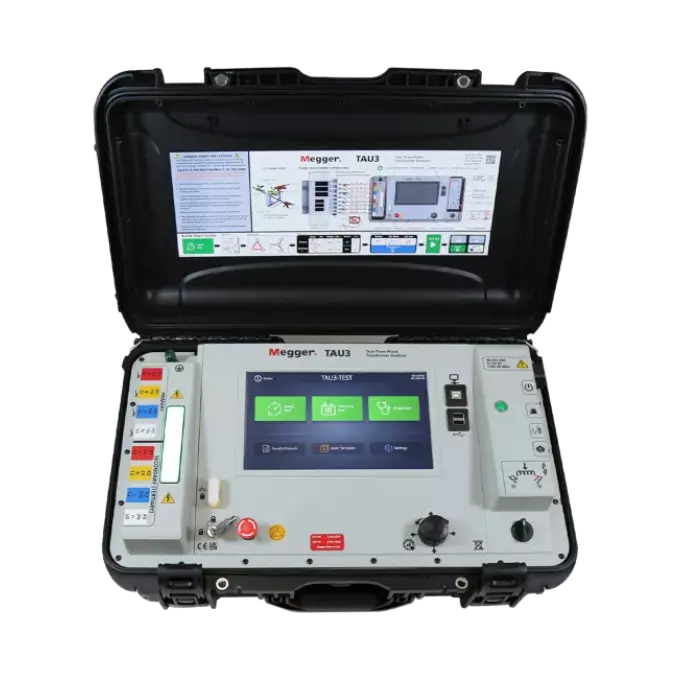Megger TAU3-PRO true three-phase transformer winding analyzer
Documents
TAU3 true three-phase transformer winding analyzer
Enhanced transformer assessment
The TAU3 simplifies maintenance decisions by allowing multiple tests to be performed with a one-time connection.
Increased safety
The one-time connection boosts health and safety of personnel using ladders or bucket trucks to connect to transformers.
Maximized productivity
Spend more time on value-added activities instead of on switching instruments and leads.
About the product
- 3 phase source and measurement for:
- Turns ratio
- Up to 250 V, ±0.05 % accuracy
- Winding resistance
- Up to 32 A, ±0.10 % accuracy
- Adaptive demagnetization
- Short circuit impedance
- Transformer efficiency
- Unique transformer vector validation
- Phase shifting and zig-zag measurements
- Accuracy guaranteed from -20 °C to 50 °C
- Safe and efficient one-time lead connection for all tests
The multifunction TAU3 streamlines transformer testing with a one-time connection for all tests, reducing reliance on multiple instruments and minimizing testing time, helping you maximize productivity for fast and accurate maintenance decisions.
In addition to routine polarity validation, turns ratio, winding resistance, and demagnetization tests, the TAU3 offers short-circuit impedance and efficiency tests with the same one-time lead connection.
Guided by color-coded leads and clamps with on-screen vectors that match the transformer nameplate, the easy-to-follow setup ensures the right result the first time… just click ‘start’ and let the patent-pending internal shorting and lead compensation do the work!
Product documents
Data sheet
Data sheet
User guide
Interpreting test results
Turns ratio results should be within 0.5% of nameplate values. The TAU3 allows the operator to input the primary and secondary voltages (or currents if testing CTs) and shows the percentage error on screen.
Winding resistance results should be within 2% when compared phase to phase. If winding resistance results exceed 2% error, ensure that the correct current and stability time are being used. When testing delta windings, it is important to allow sufficient stabilization time. If measurements are not allowed long enough to stabilize, results may not be accurate. This is typically a problem on larger transformers and transformers with derated tertiaries.
Demagnetization is an important step after winding resistance tests. These tests saturate the transformer core with DC voltage and use DC current to perform measurements. This magnetizes the transformer core. If this magnetization is not removed after testing, the transformer may be subjected to large inrush currents when reenergized. This could cause protection equipment to trip and lead to significant amounts of time being wasted trying to determine the root cause of the trip – which could have been avoided! The TAU3 displays before and after magnetic remanence, ensuring that the transformer is in the proper state to be reenergized.
Short circuit impedance values should be within 3% of nameplate values. The TAU3 allows the operator to input nameplate KVA and Z% and will display the measured percentage error on screen.
Efficiency is a critical consideration for all transformers, especially those used in distribution. With tens of millions of distribution transformers in use worldwide, poor transformer efficiency represents the biggest potential loss of revenue. When considering which transformers should continue in service, efficiency is an important metric alongside electromechanical reliability. The TAU3 displays the load and no-load losses, and efficiency of transformers to aid comparative fleet analysis.
Specifications
| Brand | Megger |
